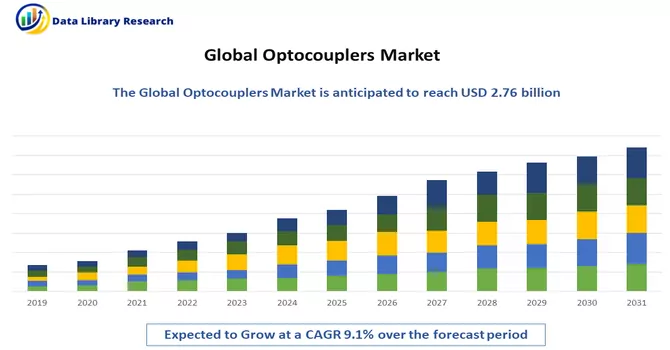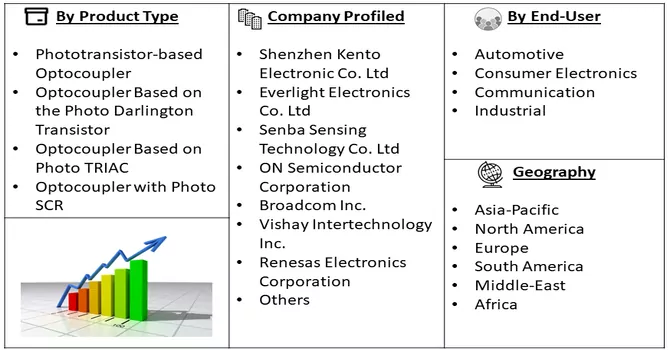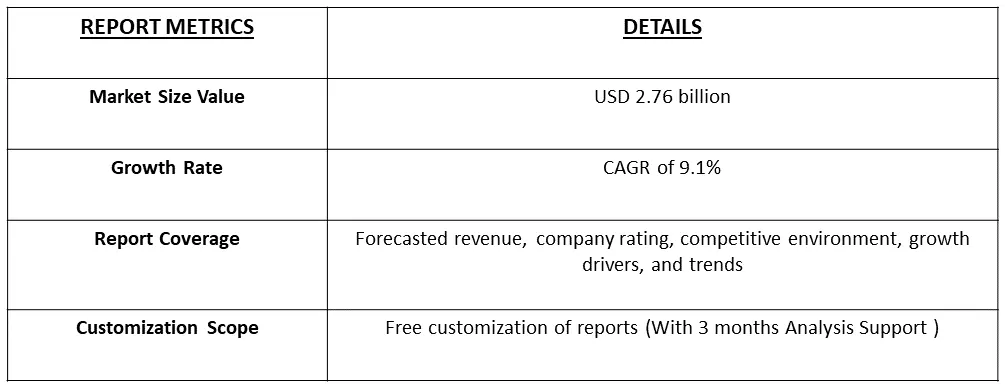The Optocouplers Market size is estimated at USD 2.76 billion in 2024 and is expected to register a CAGR of 9.1% during the forecast period (2024-2031).

Get Complete Analysis Of The Report - Download Free Sample PDF
Optocouplers, also known as opto-isolators, are electronic components that transfer electrical signals between two isolated circuits using light. They typically consist of a light-emitting diode (LED) that emits light when current flows through it, and a photodetector such as a photodiode or phototransistor that detects the emitted light and generates an electrical signal. Optocouplers are used to provide electrical isolation between input and output circuits, preventing the flow of electrical current and providing protection against voltage surges, noise, and ground loops. They are commonly used in applications such as digital logic circuits, power supplies, and industrial automation systems to transmit signals without direct electrical connection, improving system reliability and safety.
The optocoupler market is experiencing robust growth, driven by the expanding industrial automation sector and the rising adoption of signal isolation solutions across various industries. This trend is expected to continue over the forecast period. Additionally, rapid advancements in optical wireless systems, coupled with the growing demand for electric and hybrid vehicles, are creating new opportunities for optocoupler manufacturers. The emergence of digital optocouplers is also contributing to market growth. These digital optocouplers offer enhanced performance and functionality compared to traditional analog versions, making them increasingly attractive to industries seeking improved signal transmission and isolation capabilities. Thus, the optocoupler market is poised for significant expansion, fueled by technological advancements and increasing demand across diverse industries.
Market Segmentation: The report covers Global Optocoupler Market Manufacturers and is segmented by Product Type (Phototransistor-based Optocoupler, Optocoupler Based on the Photo Darlington Transistor, Optocoupler Based on Photo TRIAC, Optocoupler with Photo SCR), by End-user Industry (Automotive, Consumer Electronics, Communication, Industrial), and Geography. The market sizes and forecasts are provided in terms of value (USD million) for all the above segments.

For Detailed Market Segmentation - Download Free Sample PDF
The optocoupler market is witnessing significant growth driven by the expanding industrial automation sector and the increasing adoption of signal isolation solutions across various industries. The rise of electric and hybrid vehicles, coupled with advancements in optical wireless systems, is creating new opportunities for optocoupler manufacturers. Additionally, the shift towards digital optocouplers from traditional analog versions, along with a focus on energy efficiency and safety, are key trends shaping the market. Emerging economies' industrialization and infrastructure development are also fueling demand, while integration with other technologies and a focus on miniaturization are driving innovation in the industry.
Market Drivers:
Increasing Demand for Hybrid Electric Vehicles
The increasing demand for hybrid electric vehicles (HEVs) is expected to have a positive impact on the optocoupler market. Optocouplers play a crucial role in HEVs, particularly in the battery management system (BMS) and power electronics, where they are used for signal isolation and voltage regulation. As the adoption of HEVs continues to rise, the demand for optocouplers for these applications is also expected to increase. Moreover, the advancements in battery technology and the need for improved performance in HEVs will drive the demand for more advanced and efficient optocouplers. Digital optocouplers, in particular, with their higher speed and enhanced functionality, are likely to see increased adoption in HEVs, further boosting the optocoupler market. Additionally, the growth of the electric vehicle (EV) infrastructure, including charging stations, will require optocouplers for various control and communication applications. This growing infrastructure will further contribute to the demand for optocouplers in the automotive sector. Thus, the increasing demand for HEVs and the associated advancements in battery technology and EV infrastructure are expected to drive growth in the optocoupler market, particularly in the automotive segment.
Increasing Industrial Automation
The increasing adoption of industrial automation is driving significant growth in the optocoupler market. Optocouplers play a crucial role in industrial automation systems by providing electrical isolation between different parts of the system, ensuring safety and reliability. One of the key drivers of this trend is the need for improved efficiency and productivity in manufacturing processes. Optocouplers are used in industrial control systems to transmit signals between different components, such as sensors, actuators, and controllers, without the risk of electrical interference or damage. This is particularly important in harsh industrial environments where electrical noise and other disturbances can affect signal integrity. Furthermore, the rise of the Industrial Internet of Things (IIoT) is driving the demand for more sophisticated and interconnected automation systems, which rely on optocouplers for secure and reliable data transmission. Optocouplers are also essential for ensuring the safety of workers and equipment in industrial settings by isolating high-voltage components from low-voltage control circuits. Thus, the increasing demand for industrial automation is expected to drive growth in the optocoupler market, particularly in applications such as factory automation, robotics, and process control. As industries continue to automate their processes to improve efficiency and reduce costs, the demand for optocouplers is likely to increase further, presenting significant opportunities for manufacturers in the market.
Market Restraints:
Intrinsic Wear-out
The concept of "Intrinsic Wear-out" refers to the natural degradation of materials and components over time due to factors like usage, stress, and environmental conditions. In the context of optocouplers, intrinsic wear-out can manifest as a decrease in performance or reliability of the device over its operational lifespan. This phenomenon is expected to have a slowing effect on the growth of the optocouplers market. As optocouplers are widely used in critical applications where reliability is paramount, any decrease in performance over time can lead to concerns regarding system safety and functionality. This may result in longer replacement cycles or the adoption of alternative technologies that offer better long-term reliability. To mitigate the impact of intrinsic wear-out, manufacturers are focusing on developing more durable and reliable optocouplers. This includes using materials with higher resistance to wear and incorporating features such as self-diagnostic capabilities to monitor the health of the device. Additionally, advancements in testing and quality control processes are being implemented to ensure that optocouplers meet stringent reliability standards. Thus, while intrinsic wear-out is expected to pose challenges to the growth of the optocouplers market, ongoing efforts in research and development are aimed at addressing these challenges and ensuring the continued relevance and reliability of optocouplers in critical applications.
The COVID-19 pandemic has had a significant impact on the couplers market, including optocouplers. The initial outbreak led to disruptions in manufacturing and supply chains, causing delays in the production and delivery of coupler components. This resulted in temporary shortages and increased lead times for couplers, including optocouplers. However, the pandemic also highlighted the importance of couplers, especially in critical applications such as medical devices, telecommunications, and data centers. Optocouplers, in particular, are essential for ensuring the isolation and reliable transmission of signals in these applications. As a result, there was a growing demand for couplers to support the increased production of medical equipment, communication devices, and other essential technologies during the pandemic. To address the challenges posed by the pandemic, coupler manufacturers implemented various measures such as increasing production capacity, optimizing supply chains, and adopting remote working practices. These efforts helped to stabilize the couplers market and meet the growing demand for couplers during the pandemic. Looking ahead, the COVID-19 pandemic is expected to have a lasting impact on the couplers market, driving continued innovation and investment in technologies that enhance the reliability and performance of couplers, including optocouplers, in critical applications.
Segmental analysis:
Phototransistor-based Optocoupler Segment is Expected to Witness Significant Growth Over the Forecast Period
Phototransistor-based optocouplers are favored for their ability to amplify weak input signals, thanks to their high sensitivity to light. This makes them ideal for applications where the incoming signal needs to be strengthened for further processing or control. Additionally, their fast response times make them suitable for high-speed switching applications, ensuring rapid signal transmission. The high gain of phototransistors allows them to produce a strong output signal for a given input light intensity, making them reliable in situations where signal integrity is crucial. Moreover, their noise immunity ensures that the output signal remains robust even in environments with high levels of electrical interference. Cost-effectiveness is another key advantage of phototransistor-based optocouplers, making them accessible for a wide range of applications. Their long-term reliability and stability further enhance their appeal, ensuring consistent performance over time. Finally, their ability to operate over a wide temperature range makes them versatile for use in various environmental conditions, making them a popular choice across industries for signal isolation and transmission needs.
Automotive Segment is Expected to Witness Significant Growth Over the Forecast Period
The automotive segment presents a significant opportunity for optocouplers, including optocouplers used in automotive applications. Optocouplers play a crucial role in automotive electronics, providing electrical isolation between different parts of the vehicle's electrical system. This isolation is essential for ensuring the safety and reliability of automotive electronics, particularly in critical systems such as the battery management system (BMS), engine control unit (ECU), and safety systems like airbags and anti-lock braking systems (ABS). In the automotive segment, optocouplers are used for various purposes, including signal isolation, voltage regulation, and interfacing between different voltage levels. For example, in the BMS of electric and hybrid vehicles, optocouplers are used to isolate the high-voltage battery from the low-voltage control circuitry, ensuring safety and preventing electrical faults. Optocouplers used in automotive applications must meet stringent requirements for temperature, voltage, and reliability. They must be able to operate reliably in harsh automotive environments, including high temperatures, humidity, and vibration. With the increasing electrification and automation of vehicles, the demand for optocouplers in the automotive segment is expected to grow. Manufacturers are focusing on developing optocouplers that meet the specific requirements of automotive applications, including higher isolation voltages, faster response times, and improved reliability. Overall, the automotive segment represents a significant growth opportunity for optocoupler manufacturers, driven by the increasing adoption of electric and hybrid vehicles and the growing complexity of automotive electronics.
Asia-Pacific Region is Expected to Witness Significant Growth Over the Forecast Period
Optocouplers are primarily known for their role in providing safety isolation to meet regulatory requirements. However, they also offer the often-overlooked benefit of isolating electrical noise, which is crucial in applications where signal integrity is paramount. The Asia-Pacific region, particularly East Asia, has seen significant growth in optocouplers due to substantial investments in the semiconductor industry and the increasing demand for efficient optoelectronic components in industrial applications. China, a key player in the semiconductor market, has been instrumental in driving the growth of optocouplers in the region. Its strong presence in the automotive sector and the development of innovative energy-efficient products contribute to the demand for optocouplers. In India, the government's initiatives to boost manufacturing, especially in the electronics sector, have led to remarkable growth. The country's focus on electronic manufacturing clusters and the increasing adoption of smartphones and other advanced electronics have fueled the demand for optocouplers. In China, the industrial sector accounts for a significant portion of the GDP, driving the demand for optocouplers as automation increases. The adoption of Industry 4.0 practices further boosts this demand, as manufacturing processes become more automated and require reliable isolation solutions like optocouplers. Optocouplers play a crucial role in electronics, particularly in embedded systems, where they are used to receive input signals from external sensors or switches. The Indian government's recent announcement of a Production Linked Incentive (PLI) scheme for domestic manufacturers of laptops, tablets, personal computers, and servers is expected to further drive the demand for optocouplers in the country.

Get Complete Analysis Of The Report - Download Free Sample PDF
The analyzed market exhibits a high degree of fragmentation, primarily attributable to the presence of numerous players operating on both a global and regional scale. The competitive landscape is characterized by a diverse array of companies, each contributing to the overall market dynamics. This fragmentation arises from the existence of specialized solution providers, established industry players, and emerging entrants, all vying for market share. The diversity in market participants is underscored by the adoption of various strategies aimed at expanding the company presence. On a global scale, companies within the studied market are strategically positioning themselves through aggressive expansion initiatives. This often involves entering new geographical regions, targeting untapped markets, and establishing a robust global footprint. The pursuit of global expansion is driven by the recognition of diverse market opportunities and the desire to capitalize on emerging trends and demands across different regions. Simultaneously, at the regional level, companies are tailoring their approaches to align with local market dynamics. Regional players are leveraging their understanding of specific market nuances, regulatory environments, and consumer preferences to gain a competitive edge. This regional focus allows companies to cater to the unique needs of local clientele, fostering stronger market penetration. To navigate the complexities of the fragmented market, companies are implementing a range of strategies. These strategies include investments in research and development to stay at the forefront of technological advancements, mergers and acquisitions to consolidate market share, strategic partnerships for synergies, and innovation to differentiate products and services. The adoption of such multifaceted strategies reflects the competitive nature of the market, with participants continually seeking avenues for growth and sustainability. In essence, the high fragmentation in the studied market not only signifies the diversity of players but also underscores the dynamism and competitiveness that drive ongoing strategic maneuvers. As companies explore various avenues for expansion, the market continues to evolve, presenting both challenges and opportunities for industry stakeholders. Major Companies in the Market Include:
Recent Development:
1) In November 2022, Vishay Intertechnology Inc. (VSH) made significant strides in diversifying its discrete product line to enhance its position in the rapidly growing optocouplers market. The company introduced the VOA300 linear optocoupler, designed for automotive applications. This device boasts an impressive 5300 Vrms isolation voltage, which is among the highest in the industry. This high isolation voltage ensures reliable signal transmission and enhances safety in automotive electronics.
2) In August 2022, Toshiba Electronic Devices & Storage Corporation expanded its lineup of smart gate driver photocouplers with the introduction of the TLP5222. This device is a 2.5A output smart gate driver photocoupler featuring a built-in automatic recovery function from protective operations. Additionally, Toshiba's lineup includes the TLP5212, TLP5214, and TLP5214A models, which do not have a built-in automatic recovery function but can reset to their normal operation through a signal input to their LED. These additions to Toshiba's lineup offer enhanced functionality and reliability, catering to the increasing demand for advanced optocoupler solutions in various industries.
Q1. What is the current Optocouplers Market size?
As per Data Library Research the Optocouplers Market size is currently estimated at USD 2.76 billion.
Q2. At what CAGR is the Optocouplers market projected to grow within the forecast period?
Optocouplers Market is expected to register a CAGR of 9.1% during the forecast period.
Q3. What are the Growth Drivers of the Optocouplers Market?
Increasing Demand for Hybrid Electric Vehicles and Increasing Industrial Automation are the Growth Drivers of the Optocouplers Market.
Q4. Which region has the largest share of the Optocouplers market? What are the largest region's market size and growth rate?
Asia-Pacific has the largest share of the market. For detailed insights on the largest region's market size and growth rate request a sample here.
Data Library Research are conducted by industry experts who offer insight on industry structure, market segmentations technology assessment and competitive landscape (CL), and penetration, as well as on emerging trends. Their analysis is based on primary interviews (~ 80%) and secondary research (~ 20%) as well as years of professional expertise in their respective industries. Adding to this, by analysing historical trends and current market positions, our analysts predict where the market will be headed for the next five years. Furthermore, the varying trends of segment & categories geographically presented are also studied and the estimated based on the primary & secondary research.
In this particular report from the supply side Data Library Research has conducted primary surveys (interviews) with the key level executives (VP, CEO’s, Marketing Director, Business Development Manager and SOFT) of the companies that active & prominent as well as the midsized organization
FIGURE 1: DLR RESEARH PROCESS

Extensive primary research was conducted to gain a deeper insight of the market and industry performance. The analysis is based on both primary and secondary research as well as years of professional expertise in the respective industries.
In addition to analysing current and historical trends, our analysts predict where the market is headed over the next five years.
It varies by segment for these categories geographically presented in the list of market tables. Speaking about this particular report we have conducted primary surveys (interviews) with the key level executives (VP, CEO’s, Marketing Director, Business Development Manager and many more) of the major players active in the market.
Secondary ResearchSecondary research was mainly used to collect and identify information useful for the extensive, technical, market-oriented, and Friend’s study of the Global Extra Neutral Alcohol. It was also used to obtain key information about major players, market classification and segmentation according to the industry trends, geographical markets, and developments related to the market and technology perspectives. For this study, analysts have gathered information from various credible sources, such as annual reports, sec filings, journals, white papers, SOFT presentations, and company web sites.
Market Size EstimationBoth, top-down and bottom-up approaches were used to estimate and validate the size of the Global market and to estimate the size of various other dependent submarkets in the overall Extra Neutral Alcohol. The key players in the market were identified through secondary research and their market contributions in the respective geographies were determined through primary and secondary research.
Forecast Model
